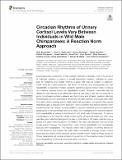Files in this item
Circadian rhythms of urinary cortisol levels vary between individuals in wild male chimpanzees : a reaction norm approach
Item metadata
| dc.contributor.author | Sonnweber, Ruth | |
| dc.contributor.author | Araya-Ajoy, Yimen G. | |
| dc.contributor.author | Behringer, Verena | |
| dc.contributor.author | Deschner, Tobias | |
| dc.contributor.author | Tkaczynski, Patrick | |
| dc.contributor.author | Fedurek, Pawel | |
| dc.contributor.author | Preis, Anna | |
| dc.contributor.author | Samuni, Liran | |
| dc.contributor.author | Zommers, Zinta | |
| dc.contributor.author | Gomes, Cristina | |
| dc.contributor.author | Zuberbühler, Klaus | |
| dc.contributor.author | Wittig, Roman M. | |
| dc.contributor.author | Crockford, Catherine | |
| dc.date.accessioned | 2019-11-21T17:30:06Z | |
| dc.date.available | 2019-11-21T17:30:06Z | |
| dc.date.issued | 2018-06-19 | |
| dc.identifier | 263483549 | |
| dc.identifier | 62542806-2c50-4cb9-b002-dba135c4fe6f | |
| dc.identifier | 85048771759 | |
| dc.identifier.citation | Sonnweber , R , Araya-Ajoy , Y G , Behringer , V , Deschner , T , Tkaczynski , P , Fedurek , P , Preis , A , Samuni , L , Zommers , Z , Gomes , C , Zuberbühler , K , Wittig , R M & Crockford , C 2018 , ' Circadian rhythms of urinary cortisol levels vary between individuals in wild male chimpanzees : a reaction norm approach ' , Frontiers in Ecology and Evolution , vol. 6 , 85 . https://doi.org/10.3389/fevo.2018.00085 | en |
| dc.identifier.issn | 2296-701X | |
| dc.identifier.other | ORCID: /0000-0001-8378-088X/work/65013934 | |
| dc.identifier.uri | https://hdl.handle.net/10023/18979 | |
| dc.description | This research was funded by The European Research Council (ERC) under the European Union's Horizon 2020 research and innovation program (Grant Agreement No 679787), awarded to CC and the Research Council of Norway (SFF-III 223257/F50). | en |
| dc.description.abstract | Investigating the repeatability of trait variation between individuals, that is the amount of individual variation in relation to overall phenotypic variation, indicates an upper level of heritability and reveals whether a given trait may be subject to selection. Labile traits are characterized by high levels of flexibility and consequently low trait repeatability is expected. Indeed, research examining glucocorticoid levels in various non-mammal species found low repeatability scores. However, mammals may be different in this respect as (i) differential maternal care early in life has the potential to prime hypothalamic-pituitary-adrenal axis functioning and (ii) allelic variation affecting hypothalamic-pituitary-adrenal axis functioning has been reported. Individuals often differ from each other in average and/or plastic labile trait expression, two aspects that can be described using a reaction norm approach. Both consistent and flexible reaction norm expression has been argued to serve adaptive purposes, depending on the stability and predictability of environmental conditions. Here, we investigated both trait and reaction norm repeatability of urinary cortisol levels in wild adult male chimpanzees. To capture the expression of the circadian urinary cortisol rhythm of individual males over time, urine samples were collected throughout the day. In total data of 30 males collected over a period of 8 years were included in the dataset. No male was sampled over the whole 8-year period however. We found minor levels of trait repeatability but considerable reaction norm repeatability. This implies a minor role of genetic or priming factors on cortisol excretion, but reveals that males differ consistently in average urinary cortisol levels and the shape of the circadian urinary cortisol rhythm. Relating these results to fitness parameters will provide answers to questions on the adaptive value of reaction norm repeatability of this labile hormonal trait in the future. | |
| dc.format.extent | 11 | |
| dc.format.extent | 1325050 | |
| dc.language.iso | eng | |
| dc.relation.ispartof | Frontiers in Ecology and Evolution | en |
| dc.subject | Circadian rhythm | en |
| dc.subject | Glucocorticoids | en |
| dc.subject | Individual differences | en |
| dc.subject | Reaction norm | en |
| dc.subject | Repeatability | en |
| dc.subject | Repeatability of plasticity | en |
| dc.subject | Ecology, Evolution, Behavior and Systematics | en |
| dc.subject | Ecology | en |
| dc.subject | DAS | en |
| dc.title | Circadian rhythms of urinary cortisol levels vary between individuals in wild male chimpanzees : a reaction norm approach | en |
| dc.type | Journal article | en |
| dc.contributor.institution | University of St Andrews. School of Psychology and Neuroscience | en |
| dc.contributor.institution | University of St Andrews. Institute of Behavioural and Neural Sciences | en |
| dc.contributor.institution | University of St Andrews. Centre for Social Learning & Cognitive Evolution | en |
| dc.identifier.doi | https://doi.org/10.3389/fevo.2018.00085 | |
| dc.description.status | Peer reviewed | en |
This item appears in the following Collection(s)
Items in the St Andrews Research Repository are protected by copyright, with all rights reserved, unless otherwise indicated.

